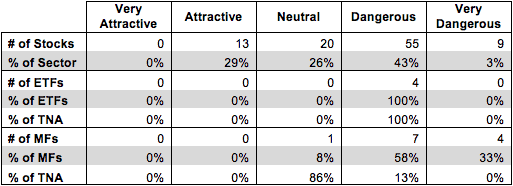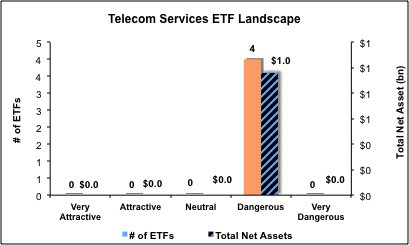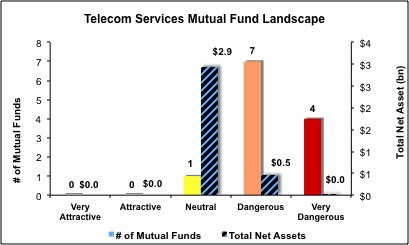The Telecom sector ranks fifth out of the ten sectors as detailed in my Sector Rankings for ETFs and Mutual Funds report. It gets my Neutral rating, which is based on aggregation of ratings of 4 ETFs and 12 mutual funds in the Telecom sector as of October 10th, 2013. Prior reports on the best & worst ETFs and mutual funds in every sector are here.
Figure 1 ranks from best to worst the four Telecom Services ETFs and Figure 2 shows the five best and worst-rated Telecom Services mutual funds. Not all Telecom sector ETFs and mutual funds are created the same. The number of holdings varies widely (from 24 to 54). This variation creates drastically different investment implications and, therefore, ratings. The best ETFs and mutual funds allocate more value to Attractive-or-better-rated stocks than the worst ETFs and mutual funds, which allocate too much value to Neutral-or-worse-rated stocks.
To identify the best and avoid the worst ETFs and mutual funds within the Telecom sector, investors need a predictive rating based on (1) stocks ratings of the holdings and (2) the all-in expenses of each ETF and mutual fund. Investors need not rely on backward-looking ratings. My fund rating methodology is detailedhere.
Investors should not buy any Telecom ETFs or mutual funds because none get an Attractive-or-better rating. If you must have exposure to this sector, you should buy a basket of Attractive-or-better rated stocks and avoid paying undeserved fund fees. Active management has a long history of not paying off.Here’s the list of our top-rated Telecom stocks.
Get my ratings on all ETFs and mutual funds in this sector on my free mutual fund and ETF screener.
Figure 1: ETFs with the Best & Worst Ratings
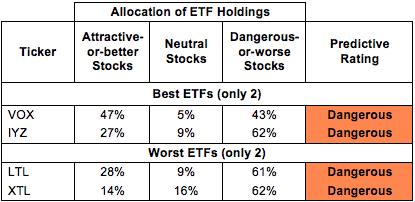 * Best ETFs exclude ETFs with TNAs less than $100 million for inadequate liquidity.
* Best ETFs exclude ETFs with TNAs less than $100 million for inadequate liquidity.
Sources: New Constructs, LLC and company filings
Figure 2: Mutual Funds with the Best & Worst Ratings – Top 5
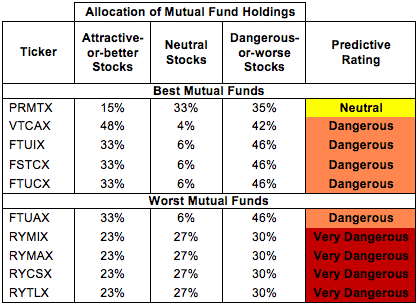 * Best mutual funds exclude funds with TNAs less than $100 million for inadequate liquidity.
* Best mutual funds exclude funds with TNAs less than $100 million for inadequate liquidity.
Sources: New Constructs, LLC and company filings
Vanguard Telecom ETF (VOX) is my top-rated Telecom ETF and T Rowe Price Media & Telecommunications Fund, Inc (PRMTX) is my top-rated Telecom mutual fund. VOX earns my Dangerous rating and PRMTX earns my Neutral rating.
State Street SPDR SPDR S&P Telecom ETF (XTL) is my worst-rated Telecom ETF and Rydex Series Funds: Telecommunications Fund (RYTLX) is my worst-rated Telecom mutual fund. XTL earns my Dangerous rating and RYTLX earns my Very Dangerous.
Figure 3 shows that 13 out of the 97 stocks (over 29% of the market value) in Telecom ETFs and mutual funds get an Attractive-or-better rating. However, no Telecom ETFs or mutual funds get an Attractive-or-better rating.
The takeaways are: mutual fund managers allocate too much capital to low-quality stocks and Telecom ETFs hold poor quality stocks.
Figure 3: Telecom Sector Landscape For ETFs, Mutual Funds & Stocks
As detailed in “Cheap Funds Dupe Investors”, the fund industry offers many cheap funds but very few funds with high-quality stocks, or with what I call good portfolio management.
Investors need to tread carefully when considering Telecom ETFs and mutual funds, as 100% of ETFs and 92% of mutual funds in the sector earn a Dangerous or worse rating. No ETFs or mutual funds in the Telecom sector allocate enough value to Attractive-or-better-rated stocks to earn an Attractive rating. Investors are better off to focus on individual stocks instead.
Vonage Holdings Corp (VG) is one of my favorite stocks held by Telecom ETFs and mutual funds and earns my Attractive rating. I love companies like Vonage because they leverage technology to provide services more efficiently. Not only does Vonage lower the costs of communication for consumers, they do so in a profitable and efficient manner by avoiding the capital intensity of the legacy networks. Vonage’s return on invested capital (ROIC) of 91% is the best in the Telecom sector by a large margin. They have been able to achieve this impressive figure by managing their working capital to maximize cash flows. The company has generated positive free cash flow every year since 2007. Vonage has also generated positive economic earnings in each of the last four years. At VG’s current stock price of ~$3, the market only expects the company to grow after tax profits (NOPAT) by another 18% over the remainder of its corporate life. For a company that has generated so much cash flow in the past, these expectations seem too low and make Vonage an attractive investment.
United States Cellular Corp (USM) is one of my least favorite stocks held by Telecom ETFs and mutual funds and earns my Dangerous rating. United States Cellular Corp has had declining after tax profits (NOPAT) in each of the last five years. Its return on invested capital (ROIC) of 3% places it in the bottom quintile of stocks that I cover, and the company has not generated positive economic earnings since 1998. At its current price of ~$44, the stock embeds expectations for NOPAT to grow by 11% compounded annually over the next 15 years. For a company struggling to be profitable, these growth expectations seem too optimistic.
40 stocks of the 3000+ I cover are classified as Telecom stocks, but due to style drift, Telecom ETFs and mutual funds hold 97 stocks.
Figures 4 and 5 show the rating landscape of all Telecom ETFs and mutual funds.
My Sector Rankings for ETFs and Mutual Funds report ranks all sectors and highlights those that offer the best investments.
Figure 4: Separating the Best ETFs From the Worst ETFs
Figure 5: Separating the Best Mutual Funds From the Worst Mutual Funds
Review my full list of ratings and rankings along with reports on all 4 ETFs and 12 mutual funds in the Telecom sector.
Jared Melnyk contributed to this report.
Disclosure: David Trainer is long VG. I receive no compensation to write about any specific stock, sector or theme.

